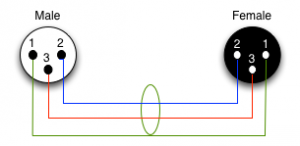 Ever stopped to wonder why XLR connectors – at least the ones on microphones – have three pins? Actually, it’s surprisingly simple, and also, if that kind of thing floats your boat, actually rather neat. Here’s a simple explanation that covers over some of the more complicated details of how, but hopefully should make it clear.
Ever stopped to wonder why XLR connectors – at least the ones on microphones – have three pins? Actually, it’s surprisingly simple, and also, if that kind of thing floats your boat, actually rather neat. Here’s a simple explanation that covers over some of the more complicated details of how, but hopefully should make it clear.
In a normal two pin connection (standard 1/4″ jack, etc) lets say our original signal has a voltage V at a particular instant in time. So at that moment we run a voltage of V down one wire, and leave the other (usually the copper shield in the cable) connected to the ground, where it can’t change. The difference between the two is then V, and that’s fine. Except that we’re talking about a low level signal in what could be an electrically noisy environment, such as your stage, with mains cables and lights all over the place. Suppose that the cable is running next to a power cable, and is picking up a small amount of mains noise, say voltage N. In our simple two conductor case, the noise will add to our signal voltage V producing a total signal of V + N. Because the other wire is connected to ground, it won’t (for all practical purposes) pick up the noise, so at the end of the cable we’ll have a signal V + N, i.e. the original signal plus the mains noise.
What about a balanced cable?
The three pins in a balanced connection are hooked up as follows:
- Ground, shielding on the cable
- Hot – positive polarity version of signal
- Cold – negative polarity version of signal
Essentially, what happens is that as the signal is fed to the balanced cable, a negative copy of it is created, and fed to the cold pin, while the positive version is fed to the hot pin. This is pretty easy to do using either a small transformer, or some fairly simple electronics.
Again, let’s say our original signal has a voltage V at a particular instant in time. The hot pin will then be at voltage V, and the cold at -V. Simple enough. At the far end, we can electronically subtract the cold signal from the hot, and get V – (-V), which is 2V. Again, subtracting one signal from another is dead easy – a small transformer or some simple electronics will do that for us – and we now have a signal at the other end of the cable that represents V. (The fact that it’s 2V doesn’t matter at all.)
In a noisy environment, we still pick up noise: the hot wire picks up a noise signal N, for a total of V + N; the cold wire also picks up N, for a total of (-V) + N.
When we subtract these at the end, we get (V + N) – ((-V) + N). If you can still remember your GCSE maths, that translates to V + N + V – N, or, magically, 2V. And the noise… disappears. Neat, huh?
Since microphone signals tend to be very low level, V and N can be quite comparable in size, so running an unbalanced lead for a microphone has the potential to produce a very noisy signal: hence, the balanced lead. Equally, the longer a cable is, the more prone to picking up rubbish it is (ask me sometime about the supposedly balanced multicore that picked up Radio Cambridgeshire!), so it’s worth making sure that long runs to amps or monitors are balanced too.
Why aren’t guitar leads balanced? In all honesty – blame Leo Fender. It’s too late to change now.
